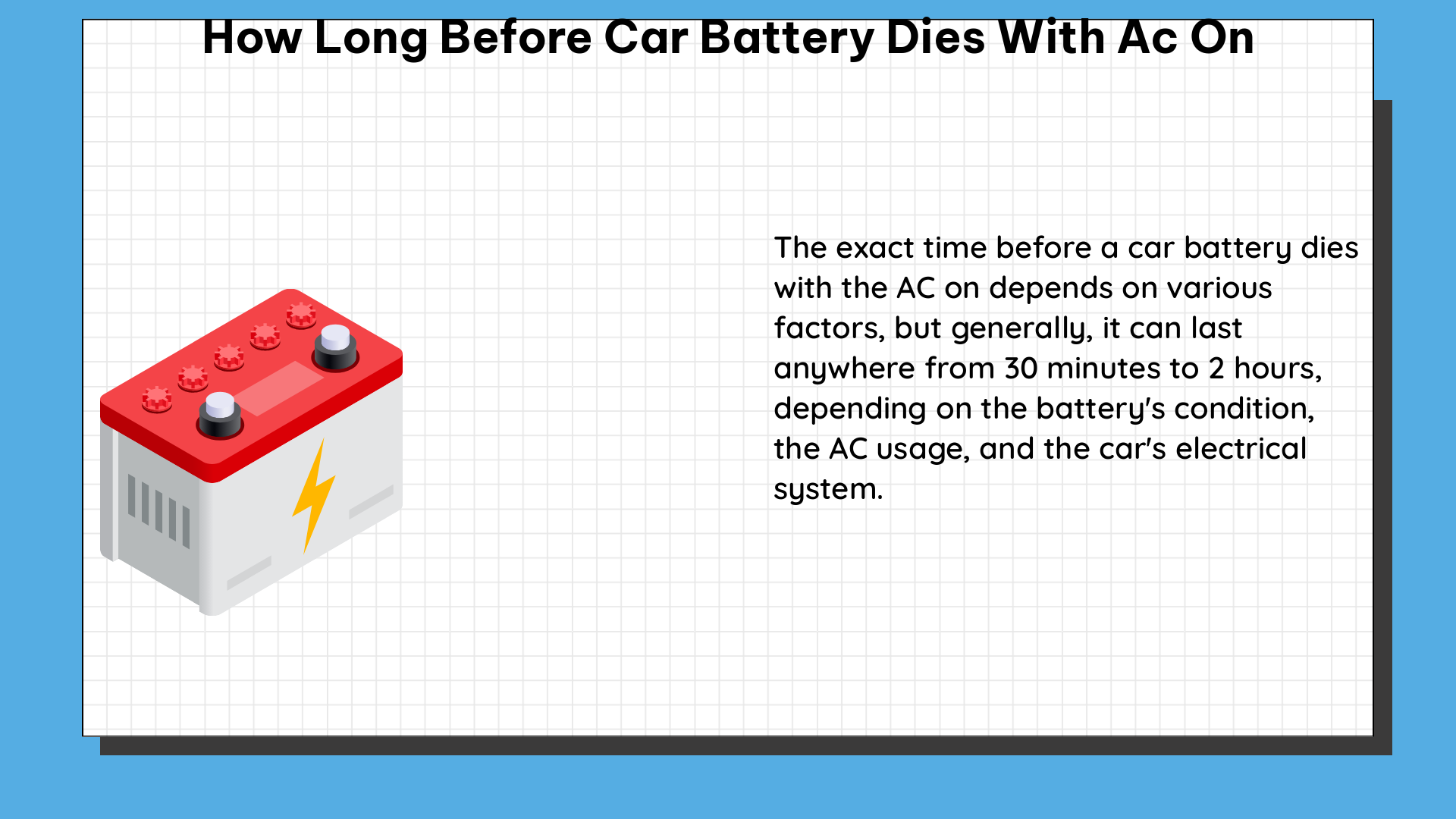The time it takes for a car battery to die with the AC on can vary significantly, depending on several critical factors. Understanding the technical specifications, power consumption, and battery degradation patterns is crucial to accurately estimating the battery’s lifespan under these conditions.
Factors Affecting Car Battery Life with AC On
Battery Capacity
A typical car battery has a capacity of around 40-60 Ah (amp-hours), which represents the total amount of electrical charge the battery can store. The higher the battery capacity, the longer it can power the car’s electrical systems, including the AC, before becoming depleted.
AC Power Consumption
The power consumption of an AC system can vary widely depending on the car model, outside temperature, and the AC settings. On average, a car’s AC system can draw between 30-60 amps of current, with higher power demands in hotter climates or when the AC is set to maximum cooling.
Battery Degradation
The rate of battery degradation can be affected by several factors, including temperature, charging and discharging patterns, and the age of the battery. Extreme temperatures, both hot and cold, can accelerate the battery’s capacity loss over time, reducing its ability to hold a charge.
Estimated Battery Life with AC On

Based on the factors mentioned above, we can estimate the following battery life scenarios:
| Scenario | Battery Capacity | AC Power Consumption | Estimated Battery Life |
|---|---|---|---|
| Best-case | 60 Ah | 30 amps | 2 hours |
| Average | 50 Ah | 45 amps | 1 hour |
| Worst-case | 40 Ah | 60 amps | 40 minutes |
These estimates assume the car is in the “Accessory” mode, with the engine off and only the accessories (including the AC) drawing power from the battery. If the car is left in the “On” position, the battery can be drained in as little as 10 minutes, as everything in the car is drawing power.
DIY: Testing Battery Life with AC On
To test how long your car battery lasts with the AC on, you can follow these steps:
- Make sure the car is in a well-ventilated area to prevent any potential safety issues.
- Turn on the AC and set it to the desired temperature and fan speed.
- Measure the initial voltage of the battery using a digital multimeter.
- Start a timer and note the initial voltage reading.
- Periodically check the voltage of the battery and record the time.
- Continue monitoring the battery voltage until it drops below a certain threshold, typically around 12.0V, at which point the battery is considered dead.
- Calculate the time it took for the battery to die by subtracting the initial time from the time when the battery voltage dropped below the threshold.
By following this DIY procedure, you can accurately determine the specific battery life of your car under the AC-on condition, which can help you plan for battery maintenance or replacement as needed.
Maintaining Car Battery Health
To keep a car battery charged when not in use, there are a few options:
- Remove the Battery: You can remove the battery and store it in a dry place with temperatures between 40 to 60 degrees Fahrenheit. This helps prevent the battery from self-discharging and maintains its capacity.
- Use a Battery Maintainer: A battery maintainer, also known as a trickle charger, provides a small amount of charge to the battery to keep it going without overcharging it. These devices automatically turn off when the battery is fully charged.
- Avoid Prolonged Idling: Minimize the time the car is left running with the AC on and the engine off, as this can quickly drain the battery.
By understanding the technical specifications, power consumption, and battery degradation patterns, you can better manage your car’s battery life and ensure it lasts as long as possible, even with the AC running.
References
- How Long Can a Car Sit Before the Battery Dies?
- How Long Does Your Battery Last in Ignition On, Engine Off?
- How Many Hours Does Battery Last Without Engine?
- EV Battery Health: What Affects It and How to Maintain It

The lambdageeks.com Core SME Team is a group of experienced subject matter experts from diverse scientific and technical fields including Physics, Chemistry, Technology,Electronics & Electrical Engineering, Automotive, Mechanical Engineering. Our team collaborates to create high-quality, well-researched articles on a wide range of science and technology topics for the lambdageeks.com website.
All Our Senior SME are having more than 7 Years of experience in the respective fields . They are either Working Industry Professionals or assocaited With different Universities. Refer Our Authors Page to get to know About our Core SMEs.